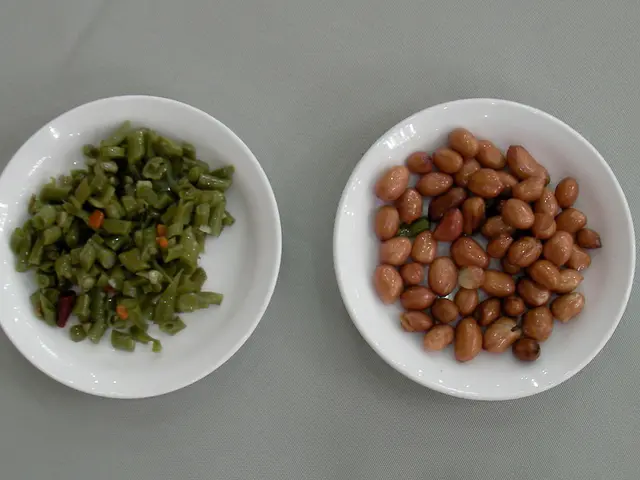Analysis of Efficiency: Cellular Energy Production via Respiration, Nutrition, and Hydration
Cellular respiration is the process by which our bodies convert the chemical energy stored in food into a form that cells can use for energy. This vital process occurs primarily within the mitochondria of cells and is essential for life as we know it.
To begin with, eating balanced meals regularly supplies the nutrients needed for efficient cellular respiration. Food is broken down into nutrients, which are carried by the blood to cells for energy production. Not all carbohydrates are sugars, but many, like starch, get broken down into sugars for cellular use.
The first stage of cellular respiration is glycolysis, which takes place in the cytoplasm. Here, one glucose molecule is broken down into two molecules of pyruvate, producing a small amount of ATP and NADH (an electron carrier).
Pyruvate then enters the mitochondria and is converted into acetyl-CoA, which feeds into the citric acid cycle (Krebs cycle). This cycle, taking place in the mitochondrial matrix, further metabolizes acetyl-CoA to produce NADH, FADH2 (another electron carrier), and a small amount of ATP, while releasing carbon dioxide as a waste product.
NADH and FADH2 donate electrons to the electron transport chain located in the inner mitochondrial membrane. The energy from electrons moving through this chain pumps protons across the membrane, creating a proton gradient. Protons flow back through ATP synthase, driving the synthesis of a large amount of ATP—a process called chemiosmosis. Oxygen acts as the final electron acceptor, combining with electrons and protons to form water.
Physical activity increases oxygen intake and distribution, improving the cells' ability to perform respiration and produce energy. Deep and regular breathing ensures complete oxygen intake for efficient energy production during respiration. Drinking plenty of water throughout the day helps deliver oxygen and nutrients to cells, supporting the respiration process.
Without breathing, food, and water, cells would not receive the energy they need, muscles would not be able to move, the brain would not be able to think, and the body would not be able to function, leading to death. Carbon dioxide, a waste gas produced during cellular respiration, is expelled during breathing.
In summary, cellular respiration efficiently converts the chemical energy in glucose into ATP through a series of enzymatic reactions and electron transfers, with oxygen essential at the end to accept electrons and allow the process to continue. Relaxation helps deepen breathing, promoting better oxygen intake for cellular respiration and overall energy production.
Cellular respiration produces ATP, small energy "batteries" that cells use to power various functions. Cells require oxygen, food, and water to produce energy through this process. Fats undergo a process to turn into the same kind of fuel used for sugar. Respiration is the process by which the body uses oxygen from the air and food to produce energy. Breathing brings oxygen into the body, which is used by cells to "burn" food for energy.
By understanding the intricacies of cellular respiration, we can appreciate the complex and interconnected processes that sustain life within each of our cells.
Engaging in health-and-wellness practices such as fitness-and-exercise and maintaining a balanced diet rich in nutrition is essential for supporting cellular respiration, the process that fuels our bodies. Deep breathing not only improves physical activity's effectiveness in increasing oxygen intake, but it also bolsters cellular respiration and overall energy production by ensuring complete oxygen uptake.







